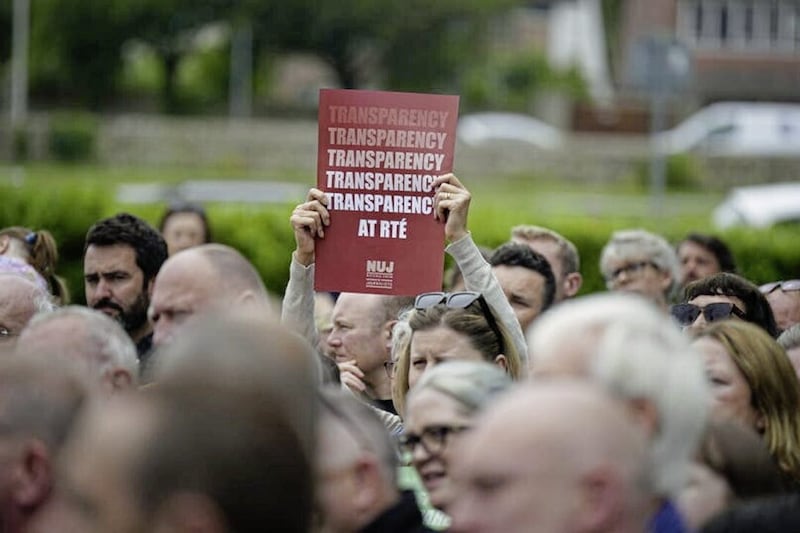Trust, says Mike Nesbitt, that’s the thing, and he has none in Sinn Féin. Fair enough, watching them duck and dive and contradict each other. How long ago it seems that Sinn Féin tactics were worked through by committee, or so it was said, before Gerry or Martin, Gerry K or Alex Maskey went out to present the policy of the moment with conviction, and at least the appearance of credibility.
There was little system and less connection between the McGuinness proper scorn for criminals who should be handed in and the Adams re-tread of his worst soundbite, to announce that the IRA had indeed gone away. Which to Mike’s ears, at that moment in simple listening mode with nuance detector firmly off, was flat contradiction of Chief Constable George Hamilton clearly telling a truth - as policing has long accepted it. Which Adams intended to echo? Because when he said the IRA has gone away he surely meant the old-form IRA had gone away.
But, but and some more but. Adams was too high-handed. The Sinn Féin president could try having an uncomfortable conversation with himself, ask himself how he might react if he wasn’t in perpetual denial, how these deaths in the Markets and Short Strand might look to a unionist of his own age, or indeed anyone else outside the belief system of mainstream republicanism. A bit more regret and embarrassment was called for, a smidgen of empathy with professedly unnerved unionism. Even pretend empathy.
The contradictions pile up. Unionists when pushed by each other to stand fast by the tribe talk themselves smack into their own double-think. The Nesbitt record is a brief one, because he went from newbie to centre-stage without even a spell in the chorus. It has still been long enough for him to line out beside loyalist paramilitary fronts, smiling as easily as when he fronts his own slightly stunned-looking party, all the while preaching decency and mutual respect. (And now a ‘principled stand.’)
Peter Robinson writes a considered response in the Belfast Telegraph with this as central declaration: ‘those who are in government in Northern Ireland cannot also be involved with those who engage in paramilitary and criminal activity.’ What does ‘involved with’ mean? Is making common cause with the PUP and UDA-fronts not involvement? Ah, said Mike, but that was to bring people into politics. When DUP and UU leaflets helped set the mob on Alliance, it was certainly a form of bringing people into politics, though scarcely decent, respectful or in the spirit of democracy.
There is nothing new in unionist righteousness about involvement with paramilitaries. It makes Sinn Féin no easier to listen to. But it is part of the same contorted thinking that produced an angry David Trimble, loath to share an executive with Sinn Féin but emboldened by walking into negotiations flanked by loyalist ex-cons: John White, Billy Hutchinson.
Well before loyalist groups declared their ceasefire, nice Lord Empey, benevolent bystander in tasteful cream jacket at Mike’s performance, sat in Belfast City Hall as the DUP and his party together made UVF and UDA front-men Hugh Smyth and Frank McCoubrey council figureheads.
There was no pretence at the time about bringing paramilitaries into politics. When John Hume introduced that concept unionist politicians denounced it, and Hume, as supping with the devil. They saw no devils in their own back-yards. Or perhaps they saw them at a healthy, manageable distance: back-yards far enough away from the daily lives of most front-line unionist politicos.
The Nesbitt hotfoot out of the Stormont executive wrong-footed DUP and Sinn Féin alike. Why not? Stormont has few admirers outside its inhabitants. But what now? In broadcasts variously described as painful and cringe-making Nesbitt and Danny Kinahan made a poor job of defending the contradictions in their own stance. The sound of Kinahan’s phone pinging frantically as he lost his way under a Stephen Nolan onslaught suggested someone on the outside trying to tell him to change tack. Nesbitt responded with flummoxed irritation to questions about his selective use of the chief constable statement, and public alignment with loyalist fronts.
In this space yesterday, Tom Kelly did a fine job of talking up an opposition Nesbitt might construct with the SDLP and Alliance, to replace the ‘ugly architecture’ Mark Durkan lamented once the SDLP lost the best office inside it, but which Durkan and his party helped to design. It is hard to see Nesbitt as a man with a trust-worthy plan.







